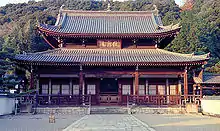| Manpuku-ji 萬福寺 | |
|---|---|
 Main Hall | |
| Religion | |
| Affiliation | Ōbaku |
| Deity | Shaka Nyorai (Śākyamuni) |
| Status | Head Temple |
| Location | |
| Location | 34 Sanban-wari, Goka-shō, Uji, Kyoto Prefecture |
| Country | Japan |
| Geographic coordinates | 34°54′51.32″N 135°48′21.83″E / 34.9142556°N 135.8060639°E |
| Architecture | |
| Founder | Yinyuan Longqi (Ingen), Muyan |
| Completed | 1661 |
| Website | |
| http://www.obakusan.or.jp/ | |
Ōbaku-san Manpuku-ji (黄檗山萬福寺, Manpuku Temple on Mt. Ōbaku) is a Buddhist temple located in Uji, Kyoto, approximately a 5-minute walk from Ōbaku Station.[1] It is the head temple of the Japanese Ōbaku Zen sect, named after Wanfu Temple in Fujian, China. The mountain is likewise named after Mount Huangbo, where the Chinese temple is situated.[2]
History
The temple was founded in 1661 by the Chinese monk Yinyuan Longqi (Ingen), officially opening in 1963.[3]
In 1664, control of the temple passed to Muyan, after which many Chinese monks followed as head priests.[4] Only the fourteenth priest and his successors are Japanese.[5]
On May 21, 1673 (Enpō 1, 5th day of the 4th month) Yinyuan (Ingen) died at the temple.[6]
The art of Senchadō is closely tied to the temple due to its founder.[7]
Architecture
The temple structures were constructed in Ming China's architectural style.[8]
The arrangement of buildings also follows Ming Dynasty architectural style, representing an image of a dragon.

The temple features an exemplary gyoban (fish board, used to toll the hours).[9]
Art
The temple treasure house contains a complete collection of Buddhist scriptures completed in 1678 and comprising approximately 60,000 printing blocks, which are still in use.[10][11] The production of the printing blocks was funded by donations collected throughout the country for many years.
The temple's main statue is a seated Gautama Buddha.
Sculptures by the Chinese sculptor known as Han Do-sei[12] and latticed balustrades can also be seen.
Gallery
 Balustrades, in manji-kuzushi (卍崩し, simplified swastika) style
Balustrades, in manji-kuzushi (卍崩し, simplified swastika) style Gate
Gate Altar to Kansei Teikun
Altar to Kansei Teikun Statue of Hotei
Statue of Hotei
See also
- Japanese Buddhism
- Zen
- Egoku Dōmyō
- Glossary of Japanese Buddhism—explanation of terms concerning Japanese Buddhism, Japanese Buddhist art, and Japanese Buddhist temple architecture
Notes
- ↑ Bornoff, Nicholas (2008). Japan. National Geographic. p. 233.
- ↑ Wu, Jiang (2015). Leaving for the Rising Sun: Chinese Zen Master Yinyuan and the Authenticity Crisis in Early Modern East Asia. Oxford University Press. p. 2. ISBN 9780199393121.
- ↑ Winfield, Pamela D.; Heine, Steven, eds. (7 June 2017). Zen and Material Culture. Oxford University Press. p. 139–140. ISBN 9780190469313.
- ↑ Buswell Jr., Robert E.; Lopez Jr., Donald S. (24 November 2013). The Princeton Dictionary of Buddhism. Princeton University Press. p. 529. ISBN 9781400848058.
- ↑ Hershock, Peter D. (14 March 2014). Public Zen, Personal Zen: A Buddhist Introduction. Rowman & Littlefield. p. 134. ISBN 9781442216143.
- ↑ Titsingh, Isaac. (1834). Annales des empereurs du japon, p. 414.
- ↑ "Volume 5". Intersect. University of Michigan: PHP Institute. 1989. p. 25. Retrieved 2 January 2024.
- ↑ Yanagida, Seizan (2009). "Historical Introduction to The Record of Linji". The Record of Linji. Honolulu: University of Hawaii Press. p. 115. ISBN 9780824833190.
- ↑ 秋山光和 (1967). 原色日本の美術: 禅寺と石庭. University of California: 小学館. p. 236.
- ↑ Konishi, Yoshiaki (3 January 2023). "Kyoto Zen temple seeks to preserve history a ramen bowl at a time". The Asahi Shimbun. Uji, Kyoto Prefecture. Retrieved 3 January 2024.
- ↑ Gustav, Konang (1972). A Millennium of Printing in China, Korea and Japan. Royal Library. p. 10. ISBN 9789170000119.
- ↑ "A Representative Magazine of Things Japanese". The Japan Magazine. Vol. 7. New York Public Library: Japan Magazine Company. 1916. Retrieved 4 January 2024.
References
- Titsingh, Isaac. (1834). Annales des empereurs du Japon. Paris: Oriental Translation Fund of Great Britain and Ireland. OCLC 251800045; see also Imprimerie Royale de France, OCLC 311322353
External links
![]() Media related to Manpuku-ji at Wikimedia Commons
Media related to Manpuku-ji at Wikimedia Commons
- Manpuku-ji – official page (map) (in Japanese)